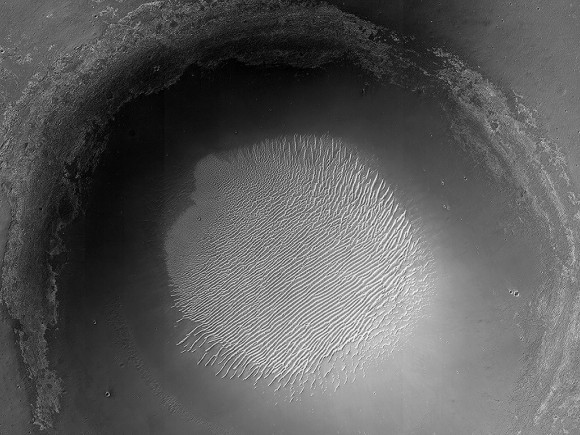| Online: | |
| Visits: | |
| Stories: |

| Story Views | |
| Now: | |
| Last Hour: | |
| Last 24 Hours: | |
| Total: | |
Captain HiRISE, Space Detective Beams Martian History Album To Earth

A large crater in Meridiani Planum on Mars, about 20 kilometers (12.4 miles) northwest of Opportunity’s landing site and 42 kilometers (24.6 miles) northwest of Endeavour Crater, where Opportunity is right now. The crater is older than Victoria Crater (another target of Opportunity’s), which is clear because it is more filled in with sediments and eroded. Credit: NASA/JPL/University of Arizona
Mars, that ever-changing and beautiful Red Planet practically next door to us, is one of the most well-studied places humans have in the universe. We’ve sent spacecraft there for about 50 years. Yet there’s still a lot of mysteries out there.
NASA’s Mars Reconnaissance Orbiter is among the investigating spacecraft in the area checking out the planet’s past and looking for any interesting clues to tell us more about how Mars — and the Earth, and the solar system, and planets in general — formed. Mars had a wetter past (as the rovers have showed us), but where the water went and why its atmosphere are so thin are among the things scientists are trying to understand.
Luckily for us, the catalog of the University of Arizona’s High Resolution Imaging Science Experiment (HiRISE) is easily available online for all of us to marvel at. Here are just some of the pictures sent back from across the solar system. To see more, look below the jump and check out this HiRISE web page.
(…)
Read the rest of Captain HiRISE, Space Detective Beams Martian History Album To Earth (130 words)
© Elizabeth Howell for Universe Today, 2014. |
Permalink |
No comment |
Post tags: HiRISE
Feed enhanced by Better Feed from Ozh
Source: http://www.universetoday.com/112387/captain-hirise-space-detective-beams-martian-history-album-to-earth/



